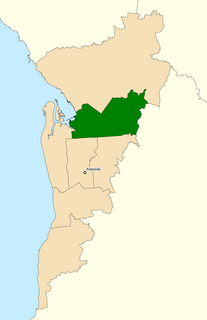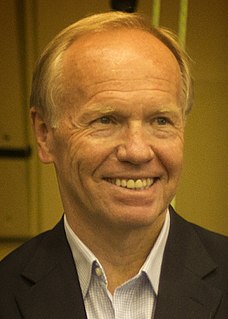| 2016 Australian federal election |
|---|
|
| National results |
| State and territory results |
This is a Mackerras pendulum for the 2016 Australian federal election.
| 2016 Australian federal election |
|---|
|
| National results |
| State and territory results |
This is a Mackerras pendulum for the 2016 Australian federal election.
The Mackerras pendulum was devised by the Australian psephologist Malcolm Mackerras as a way of predicting the outcome of an election contested between two major parties in a Westminster style lower house legislature such as the Australian House of Representatives, which is composed of single-member electorates and which uses a preferential voting system such as a Condorcet method or IRV.
The pendulum works by lining up all of the seats held in Parliament for the government, the opposition and the crossbench according to the percentage point margin they are held by on a two-party or two-candidate basis. This is also known as the swing required for the seat to change hands. Given a uniform swing to the opposition or government parties, the number of seats that change hands can be predicted.
Classification of seats as marginal, fairly safe or safe is applied by the independent Australian Electoral Commission using the following definition: "Where a winning party receives less than 56% of the vote, the seat is classified as 'marginal', 56–60% is classified as 'fairly safe' and more than 60% is considered 'safe'." [1]
Based on the 2013 post-election pendulum for the Australian federal election, this pendulum has been updated to include new notional margin estimates due to redistributions in New South Wales, Western Australia and the Australian Capital Territory. The net effect of the redistributions reduced the Liberal/National Coalition from 90 to a notional 88 seats and increased Labor from 55 to a notional 57 seats. [2] [3]
Whilst every federal election after 1961 has been won by those that also won the majority of federal seats in New South Wales, unusually nearly half of all marginal government seats are in New South Wales at this election of which nearly half are all in Western Sydney and the other half all in rural and regional areas, and with no more than a few seats each in every other state.
Assuming a theoretical uniform swing, for the Labor opposition to get to 76 seats and majority government would require Labor with 50.5 percent of the two-party vote from a 4.0-point two-party swing or greater, while for the incumbent Coalition to lose majority government would require the Coalition with 50.2 percent of the two-party vote from a 3.3-point two-party swing or greater. [4]
a Though the seats of Dobell, Paterson and Barton were Liberal wins at the previous election, redistributions changed them in to notionally marginal Labor seats. [2]
b Pat Conroy is the current MP for the Division of Charlton which is being renamed to the Division of Hunter at the next election.

The Division of Barton is an Australian electoral division in the state of New South Wales.

The Division of Dobell is an Australian electoral division in the state of New South Wales.

The Division of Makin is an electoral division for the Australian House of Representatives located in the northeastern suburbs of Adelaide. The 130 km² seat covers an area from Little Para River and Gould Creek in the north-east to Grand Junction Road in the south and Port Wakefield Road in the west, including the suburbs of Banksia Park, Fairview Park, Golden Grove, Greenwith, Gulfview Heights, Ingle Farm, Mawson Lakes, Modbury, Para Hills, Para Vista, Pooraka, Redwood Park, Ridgehaven, Salisbury East, Salisbury Heights, St Agnes, Surrey Downs, Tea Tree Gully, Valley View, Vista, Walkley Heights, Wynn Vale, Yatala Vale, and parts of Gepps Cross and Hope Valley.

The 1990 Australian federal election was held in Australia on 24 March 1990. All 148 seats in the House of Representatives and 40 seats in the 76-member Senate were up for election. The incumbent Australian Labor Party led by Bob Hawke defeated the opposition Liberal Party of Australia led by Andrew Peacock with coalition partner the National Party of Australia led by Charles Blunt despite losing the two-party-preferred vote. The election saw the reelection of a Hawke government, the fourth successive term.

An election was held in the Australian state of Queensland on 9 September 2006 to elect the 89 members of the state's Legislative Assembly, after being announced by Premier Peter Beattie on 15 August 2006.

Elections for the 54th Parliament of New South Wales were held on Saturday, 24 March 2007. The entire Legislative Assembly and half of the Legislative Council was up for election. The Labor Party led by Morris Iemma won a fourth four-year term against the Liberal-National coalition led by Peter Debnam.
The Mackerras pendulum was devised by the Australian psephologist Malcolm Mackerras as a way of predicting the outcome of an election contested between two major parties in a Westminster style lower house legislature such as the Australian House of Representatives, which is composed of single-member electorates and which uses a preferential voting system such as a Condorcet method or IRV.

In Australian politics, the two-party-preferred vote is the result of an election or opinion poll after preferences have been distributed to the highest two candidates, who in some cases can be independents. For the purposes of TPP, the Liberal/National Coalition is usually considered a single party, with Labor being the other major party. Typically the TPP is expressed as the percentages of votes attracted by each of the two major parties, e.g. "Coalition 50%, Labor 50%", where the values include both primary votes and preferences. The TPP is an indicator of how much swing has been attained/is required to change the result, taking into consideration preferences, which may have a significant effect on the result.

The 2010 Australian federal election was held on Saturday, 21 August 2010 to elect members of the 43rd Parliament of Australia. The incumbent centre-left Australian Labor Party led by Prime Minister Julia Gillard won a second term against the opposition centre-right Liberal Party of Australia led by Opposition Leader Tony Abbott and Coalition partner the National Party of Australia, led by Warren Truss, after Labor formed a minority government with the support of three independent MPs and one Australian Greens MP.

The Northern Territory general election was held on Saturday 25 August 2012, which elected all 25 members of the Legislative Assembly in the unicameral Northern Territory Parliament. The 11-year Labor Party government led by Chief Minister Paul Henderson was defeated in their attempt to win a fourth term against the opposition Country Liberal Party led by opposition leader Terry Mills with a swing of four seats, losing the normally safe Labor remote seats of Arafura, Arnhem, Daly and Stuart, whilst retaining their urban seats picked up at the 2001 election.

The 2014 South Australian state election elected members to the 53rd Parliament of South Australia on 15 March 2014, to fill all 47 seats in the House of Assembly and 11 of 22 seats in the Legislative Council. The 12-year-incumbent Australian Labor Party (SA) government, led by Premier Jay Weatherill, won its fourth consecutive four-year term in government, a record 16 years of Labor government, defeating the opposition Liberal Party of Australia (SA), led by Opposition Leader Steven Marshall.
The following is a pendulum based on the outcome of the 2010 federal election and changes since, including the redistributions of seats in South Australia and Victoria. It is a Mackerras Pendulum, invented by psephologist Malcolm Mackerras, which works by lining up all of the seats held in Parliament according to the percentage point margin on a two-candidate-preferred basis. The two-party result is also known as the swing required for the seat to change hands. Given a uniform swing to the opposition or government parties in an election, the number of seats that change hands can be predicted. Swings are never uniform, but in practice variations of swing among the Australian states usually tend to cancel each other out. Seats are arranged in safeness categories according to the Australian Electoral Commission's (AEC) classification of safeness. "Safe" seats require a swing of over 10 per cent to change, "fairly safe" seats require a swing of between 6 and 10 per cent, while "marginal" seats require a swing of less than 6 per cent. The swings for South Australian and Victorian seats are notional, based on calculations by the AEC.

The 2016 Australian federal election was a double dissolution election held on Saturday 2 July to elect all 226 members of the 45th Parliament of Australia, after an extended eight-week official campaign period. It was the first double dissolution election since the 1987 election and the first under a new voting system for the Senate that replaced group voting tickets with optional preferential voting.
At the 2016 federal election of the 150 House of Representatives seats the Liberal/National Coalition won 76, a one-seat majority, Labor won 69 seats and crossbenchers won the remaining five. A redistribution in 2017/18 changed the representation entitlements. For the next election, the number of seats in the House will increase to 151, South Australia will lose a seat, Victoria and the Australian Capital Territory (ACT) will gain one seat each.
The following pendulum is known as the Mackerras Pendulum, invented by psephologist Malcolm Mackerras. Based upon the outcome of the 2007 federal election and changes before the 2010 election, the pendulum works by lining up all of the seats held in Parliament, 83 Labor, 55 Liberal, 9 National, and 3 independent, according to the percentage point margin on a two party preferred basis.
The following is a Mackerras pendulum for the upcoming 2014 Victorian state election.
The Coalition won the 2013 federal election with 90 of 150 lower house seats on a current 17-seat, 3.65-point two-party swing, defeating the 6-year Labor government. Labor holds 55 seats while crossbenchers hold the remaining five. The Division of Fairfax was the last seat to be declared.
The Coalition won the 2016 federal election with a one-seat majority 76 of 150 lower house seats. Labor holds 69 seats while crossbenchers hold the remaining five.
The Mackerras pendulum was devised by the Australian psephologist Malcolm Mackerras as a way of predicting the outcome of an election contested between two major parties in a Westminster style lower house legislature such as the Australian House of Representatives, which is composed of single-member electorates and which uses a preferential voting system such as a Condorcet method or IRV.
The Coalition won the 2019 federal election with a two-seat majority 77 of 151 lower house seats. Labor holds 68 seats while crossbenchers hold the remaining six.